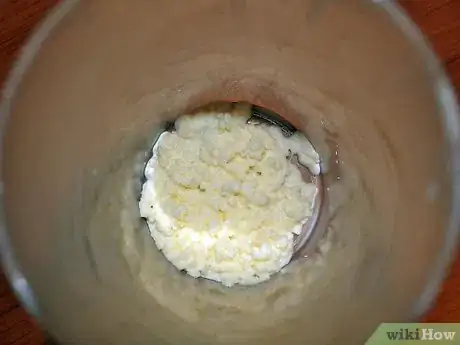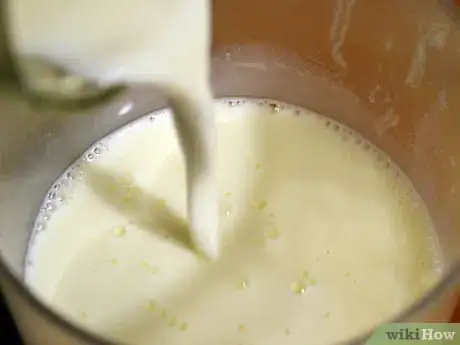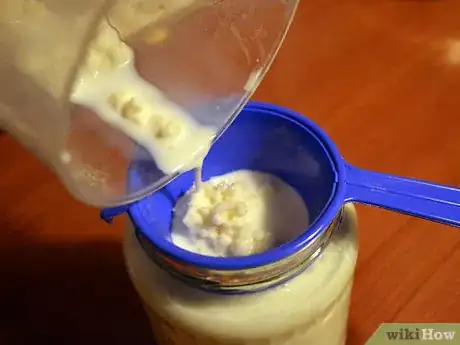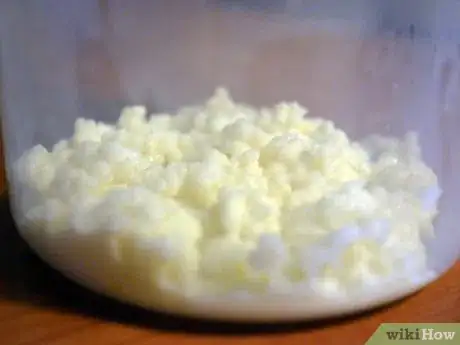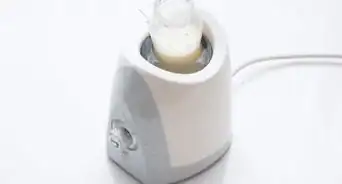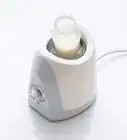wikiHow is a “wiki,” similar to Wikipedia, which means that many of our articles are co-written by multiple authors. To create this article, 13 people, some anonymous, worked to edit and improve it over time.
There are 8 references cited in this article, which can be found at the bottom of the page.
wikiHow marks an article as reader-approved once it receives enough positive feedback. This article received 20 testimonials and 95% of readers who voted found it helpful, earning it our reader-approved status.
This article has been viewed 328,913 times.
Learn more...
Kefir is a cultured milk beverage that originally hails from Russia. It is made by fermenting milk (whether from a cow, goat, or sheep) using both yeast and bacteria. With a sour, creamy taste similar to yogurt, kefir is touted for its probiotic benefits. Kefir can be easily made at home, but requires an initial purchase of "kefir grains," the name for the small clumps of yeast and bacteria mixed with proteins, sugars, and fats. These grains can be used indefinitely if maintained properly, allowing for a new batch of kefir to be prepared each day. Learning how to maintain kefir grains is a process requiring minimal time and effort.
Steps
-
1Purchase some kefir grains. There are several ways to obtain kefir grains. The cheapest way is to ask a kefir hobbyist in your area for some of their excess kefir grains. Anyone who prepares kefir regularly will be constantly throwing out excess grains, as the yeast and bacteria reproduce quickly. They may be willing to give you some at little or no cost. Another option is purchasing kefir grains from either a health food store or a specialty store that sells culturing supplies.[1]
-
2Place the kefir grains into a glass or plastic jar. When you receive your kefir grains, you can choose to rinse away some of the fat solids if desired, but do not use chlorinated water. The chlorine will kill the microorganisms in the grains. Place the grains into a clean jar.
- People often recommend handling the kefir grains with plastic utensils. Different sorts of metals react with the acids in kefir and this can adversely affect the microorganisms' health. However, high quality stainless steel is considered safe because it is non-reactive. Unless it is rusty or showing corrosion, any stainless steel kitchen equipment will be suitable.
Advertisement -
3Fill the jar with milk. The exact ratio of milk to kefir grains is not crucial, but a general rule is to use 20 parts milk to 1 part grains by volume. The milk provides food for the yeast and bacteria, and will keep your kefir grains healthy and active. Place a loose-fitting lid on the jar, and leave it out at room temperature for 24 hours.
-
4Remove the kefir grains from the milk. After 24 hours, use a plastic spoon to remove the kefir grains, which will be floating on the milk's surface. Place them in another clean jar. The milk has now been transformed into kefir, which can be consumed immediately or stored in the refrigerator.
-
5Pour more milk into the jar with the kefir grains. The simplest way to maintain your kefir grains indefinitely is to continually use them to prepare kefir. By pouring more milk into the new jar, you can prepare another batch of kefir in 24 hours, after which you can remove the grains. Repeating this process endlessly will keep your kefir grains healthy and active, while providing you with a continuous supply of kefir.
- If you don't need this much kefir, you can still keep the grains healthy in milk at room temperature. Instead of adding a full jar's worth of milk each day, simply pour off a portion of the old milk and top it off with some fresh milk. Doing this daily will provide enough food for the microorganisms to stay healthy.
- You don't need to be concerned about the milk spoiling, even at room temperature. The beneficial yeast and bacteria in the grains reproduce so rapidly in the milk that harmful bacteria do not have a chance to proliferate.
-
6Storing the kefir grains in the refrigerator will slow the microorganisms' growth but it is not suitable for the long term. If your kefir is in the fridge fresh milk only needs to be added once a week.[2] . However, leaving the kefir grains in the refrigerator for a long time will affect the balance of bacterial species and could change your kefir permanently. Fortunately, kefir can be left sitting in a cool, dark place for weeks on end without receiving any fresh milk. If you will be away from home for a short period (the longest we've done this for is five weeks), simply feed your kefir with fresh milk on the day you leave and put the jar into a dark cupboard. On your return, bring home some fresh milk for your kefir and begin feeding it again.
Community Q&A
-
QuestionShould I clean the glass jar every time I finish harvesting grains?
 Community AnswerI don't. I just return the grains and add more milk. I wash my jar every couple of weeks on average.
Community AnswerI don't. I just return the grains and add more milk. I wash my jar every couple of weeks on average. -
QuestionIf the room temperature will be lower because it is fall, will that slow down the grains? Is there an optimum temperature?
 Community AnswerProduction slows down in cooler weather. Keep the grains around 68 to 72 degrees Fahrenheit. But kefir will eventually develop even if you leave the container in the fridge, so there is quite a range of temperatures that are acceptable.
Community AnswerProduction slows down in cooler weather. Keep the grains around 68 to 72 degrees Fahrenheit. But kefir will eventually develop even if you leave the container in the fridge, so there is quite a range of temperatures that are acceptable. -
QuestionI have extra starter grains and nobody wants them. Can I use them for bread, pancakes, etc?
 Community AnswerYes. I sometimes leave some grains in the kefir I am drinking, and I also put extra grains in with ingredients for smoothies - a boost in prebiotic.
Community AnswerYes. I sometimes leave some grains in the kefir I am drinking, and I also put extra grains in with ingredients for smoothies - a boost in prebiotic.
Warnings
- If your kefir grains are dormant or dead, you may end up with rancid milk, which should not be consumed. Properly fermented kefir should have a tart, sour aroma, like Belgian beer, yogurt, or sourdough bread. Spoiled milk will smell musky, bitter, and rancid, and the kefir grains will not have increased in size or abundance.⧼thumbs_response⧽
Things You'll Need
- Kefir grains
- Glass jar
- Dechlorinated water
- Plastic spoon
- Milk
- Refrigerator
- Envelope
References
- ↑ http://www.wikihow.com/Buy-Kefir-Grains
- ↑ https://www.youtube.com/watch?v=23KuUcN8wgI
- http://users.sa.chariot.net.au/~dna/index.html
- http://cheese.notyourhomework.net/kefir/kefir.html
- http://cheese.notyourhomework.net/kefir/yoghurt.html
- https://www.culturesforhealth.com/learn/milk-kefir/milk-kefir-frequently-asked-questions-faq/
- http://www.kefir.net/what-is-kefir/
- https://www.gardenguides.com/102065-start-kefir-grains.html
About This Article
To maintain kefir grains, put them in a jar, fill the jar with milk using a ratio of 20 parts milk to 1 part grains, and let the grains sit for 24 hours. Next, use a spoon to remove the grains and place them in a clean jar. The milk is now kefir, which can be stored or consumed. You can then keep adding fresh milk to the same batch of grains to make additional batches. Repeating the process will keep the grains healthy and active, and provide you with fresh kefir every 24 hours. For tips on what to do if you can't add start a new batch within 24 hours, read on!

